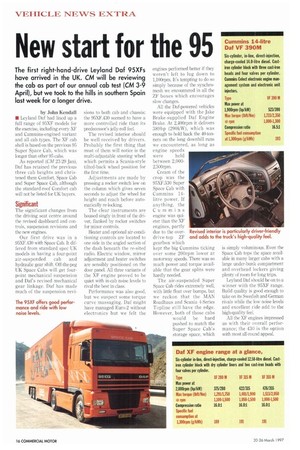New start for the 95
Page 18

If you've noticed an error in this article please click here to report it so we can fix it.
by John Kendall • Leyland Oaf had lined up a full range of 95XF models for the exercise, including every XF and Cummins-engined variant and all cab types. The XF cab shell is based on the previous 95 Super Space Cab, which was longer than other 95 cabs.
As reported (GM 23-29 Jan), Daf has retained the previous three cab heights and christened them Comfort, Space Cab and Super Space Cab, although the standard-roof Comfort cab will not be listed for UK buyers.
Significant
The significant changes from the driving seat centre around the revised dashboard and controls, suspension revisions and the new engines, Our first drive was in a 95XF.430 with Space Cab. It differed from standard spec UK models in having a four-point air-suspended cab and hydraulic gear shift. Off-the-peg UK Space Cabs will get fourpoint mechanical suspension and Oaf's revised mechanical gear linkage. Daf has made much of the suspension revi sions to both cab and chassis: the 95XFA30 seemed to have a more controlled ride than its predecessor's jelly-roll feel.
The revised interior should be well received by drivers. Probably the first thing that most of them will notice is the multi-adjustable steering wheel which permits a Scania-style tilted-back wheel position for the first time.
Adjustments are made by pressing a rocker switch low on the column which gives seven seconds to adjust the wheel for height and reach before automatically re-locking.
The clear instruments are housed singly in front of the driver, flanked by rocker switches for minor controls.
Heater and optional air-conditioning controls are located to one side in the angled section of the dash beneath the re-sited radio. Electric window, mirror adjustment and heater switches are sensibly positioned on the door panel. All three variants of the XF engine proved to be quiet with in-cab noise levels to rival the best in class.
Performance was also good, but we suspect some torque curve massaging. Oaf might have managed Euro-2 without electronics but we felt the
engines performed better if they weren't left to lug down to 1 ,10Orpm. It's tempting to do so simply because of the synchromesh we encountered in all the 7..F boxes which encourages slow changes.
All the Oaf-powered vehicles were equipped with the Jake Brake-supplied Daf Engine Brake. At 2,400rpm it delivers 389hp (290kW), which was enough to hold back the 40-tonners on the long downhill runs we encountered, as long as engine speeds were held between 2,0002.50Orpm.
Cream of the crop was the 95XF,530 Super Space Cab with Cummins 14litre power. If anything, the Cummins engine was quieter than the XF engines, partly due to the overdrive-top ZF gearbox which kept the big Cummins ticking over some 200rpm lower at motorway speeds. There was so much power and torque available that the gear splits were hardly needed.
The air-suspended Super Space Cab rides extremely well, with little float over bumps, but we reckon that the MAN Roadhaus and Scania 4-Series Topline still have the edge. However, both of those cabs would be hard pushed to match the Super Space Cab's storage space, which
is simply voluminous. Even the Space Cab tops the space available in many larger cabs with a large under-bunk compartment and overhead lockers giving plenty of room for long trips.
Leyland Oaf should be on to a winner with the 95XF range. Build quality is good enough to take on its Swedish and German rivals while the low noise levels and excellent ride add to the high-quality feel.
All the XF engines impressed us with their overall performance; the 430 is the option with most all-round appeal.
















































































































